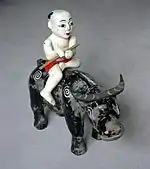
Ten Bulls or Ten Ox Herding Pictures (Chinese: shíniú 十牛 , Japanese: jūgyūzu 十牛図 , korean: sipwoo 십우) is a series of short poems and accompanying drawings used in the Zen tradition to describe the stages of a practitioner's progress toward enlightenment,[web 1] and their return to society to enact wisdom and compassion.
History
Scriptural origins
The calf, bull, or ox is one of the earliest similes for meditation practice. It comes from the Maha Gopalaka Sutta (Majjhima Nikaya 33). It is also used in the commentaries, especially the one on the Maha Satipatthana Sutta (Digha Nikaya 22) and the Satipatthana Sutta (Majjhima Nikaya 10). As Buddhism spread throughout South-East Asia, the simile of the bull spread with it.[web 2]
Chinese pictures
The well-known ten ox-herding pictures emerged in China in the 12th century. D.T. Suzuki mentions four Chinese versions of the Oxherding Pictures, by Ching-chu (Jp. Seikyo)(11th century), Tzu-te Hui (Jp. Jitoku)(1090-1159), an unknown author, and Kuòān Shīyuǎn (Jp. Kaku-an) (12th century).[web 3][web 4]
Early versions
The first series was probably made by Ching-chu in the 11th century, who may have been a contemporary of Kuòān Shīyuǎn.[web 4] There are only five pictures in Ching-chu's version and the ox's colour changes from dark to white, representing the gradual development of the practitioner, ending in the disappearance of the practitioner.[web 3]
Tzu-te Hui (自得慧暉, Zide Huihui, Jp. Jitoku) (1090-1159) made a version with six pictures. The sixth one goes beyond the stage of absolute emptiness, where Ching-chu's version ends.[web 4] Just like Ching-chu's version, the ox grows whiter along the way.[web 3][note 1]
A third version by an unknown author, with ten pictures, was the most popular in China. It derives from the Ching-chu and Tzu-te Hui series of pictures, and has a somewhat different series of pictures compared to Kuòān Shīyuǎn's version.[web 3][web 5] The 1585-edition contains a preface by Chu-hung, and it has ten pictures, each of which is preceded by Pu-ming's poem, of whom Chu-hung provides no further information. In this version the ox's colour changes from dark to white.[web 3][note 1]
Famous versions
The best known version of the oxherding pictures was drawn by the 12th century Chinese Rinzai Chán (Zen) master Kuòān Shīyuǎn (廓庵師遠, Jp. Kaku-an Shi-en), who also wrote accompanying poems and introductory words attached to the pictures. In Kuòān Shīyuǎn's version, there is no whitening process, and his series also doesn't end with mere emptiness, or absolute truth, but shows a return to the world, depicting Putai, the laughing Buddha. In Japan, Kuòān Shīyuǎn's version gained a wide circulation, the earliest one probably belonging to the fifteenth century.[web 3]
Liaoan Qingyu (了菴清欲, Jp. Ryōan Seiyoku) (1288-1363) made another version with five pictures.[web 6]
Kuòān Shīyuǎn's Ten Bulls
Verses by Kuòān Shīyuǎn; translation by Senzaki Nyogen (千崎如幻) (1876–1958) and Paul Reps (1895-1990);[web 4] paintings traditionally attributed to Tenshō Shūbun (天章周文) (1414-1463).[web 7]
 1. In Search of the Bull
1. In Search of the Bull
In the pasture of the world,
I endlessly push aside the tall
grasses in search of the Ox.
Following unnamed rivers,
lost upon the interpenetrating
paths of distant mountains,
My strength failing and my vitality exhausted, I cannot find the Ox.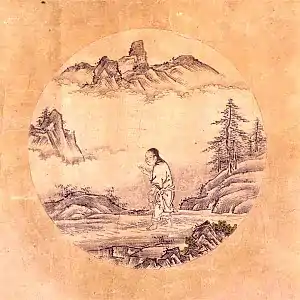 2. Discovery of the Footprints
2. Discovery of the Footprints
Along the riverbank under the trees,
I discover footprints.
Even under the fragrant grass,
I see his prints.
Deep in remote mountains they are found.
These traces can no more be hidden
than one's nose, looking heavenward.[web 8]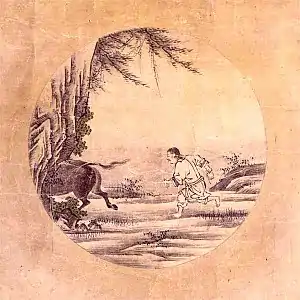 3. Perceiving the Bull
3. Perceiving the Bull
I hear the song of the nightingale.
The sun is warm, the wind is mild,
willows are green along the shore -
Here no Ox can hide!
What artist can draw that massive head,
those majestic horns?[web 8]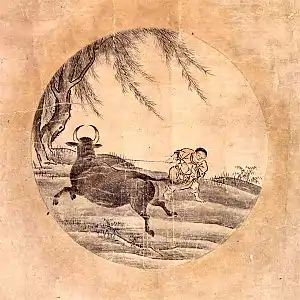 4. Catching the Bull
4. Catching the Bull
I seize him with a terrific struggle.
His great will and power
are inexhaustible.
He charges to the high plateau
far above the cloud-mists,
Or in an impenetrable ravine he stands.[web 8]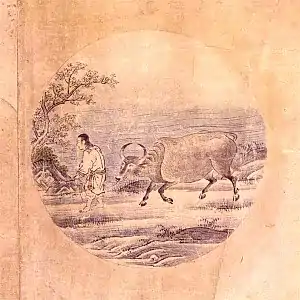 5. Taming the Bull
5. Taming the Bull
The whip and rope are necessary,
Else he might stray off down
some dusty road.
Being well-trained, he becomes
naturally gentle.
Then, unfettered, he obeys his master.[web 8] 6. Riding the Bull Home
6. Riding the Bull Home
Mounting the Ox, slowly
I return homeward.
The voice of my flute intones
through the evening.
Measuring with hand-beats
the pulsating harmony,
I direct the endless rhythm.
Whoever hears this melody
will join me.[web 8] 7. The Bull Transcended
7. The Bull Transcended
Astride the Ox, I reach home.
I am serene. The Ox too can rest.
The dawn has come. In blissful repose,
Within my thatched dwelling
I have abandoned the whip and ropes.[web 8] 8. Both Bull and Self Transcended
8. Both Bull and Self Transcended
Whip, rope, person, and Ox -
all merge in No Thing.
This heaven is so vast,
no message can stain it.
How may a snowflake exist
in a raging fire.
Here are the footprints of
the Ancestors.[web 8]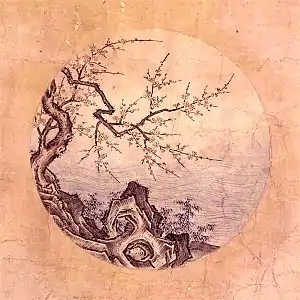 9. Reaching the Source
9. Reaching the Source
Too many steps have been taken
returning to the root and the source.
Better to have been blind and deaf
from the beginning!
Dwelling in one's true abode,
unconcerned with and without -
The river flows tranquilly on
and the flowers are red.[web 8] 10. Return to Society
10. Return to Society
Barefooted and naked of breast,
I mingle with the people of the world.
My clothes are ragged and dust-laden,
and I am ever blissful.
I use no magic to extend my life;
Now, before me, the dead trees
become alive.[web 8]
Influence and cultural legacy
.png.webp)
The ox-herding pictures had an immediate and extensive influence on the Chinese practice of Chan Buddhism.[1] According to Chi Kwang Sunim, they may represent a Zen Buddhist interpretation of the ten Bodhisattva bhumi, the ten stages on the Bodhisattva-path.[web 9]
The pictures first became widely known in the West after their inclusion in the 1957 book, Zen Flesh, Zen Bones: A Collection of Zen and Pre-Zen Writings, by Paul Reps and Nyogen Senzaki. Alan Watts included a description of the Ten Bulls in The Spirit of Zen.[2] The pictures went on to influence the work of John Cage, particularly in his emphasis on rhythmic silence, and on images of nothingness.[3] The pictures, especially the last one ('In the Marketplace'), have provided a conceptual umbrella for those Buddhists seeking a greater engagement with the post-industrial global marketplace.[4]
Cat Stevens' sixth studio album Catch Bull at Four is a reference to the 4th step towards enlightenment. On the album, the song Sitting refers to meditation, and the apprehensions that may result from the experiences resulting from enlightenment. Catch Bull at Four was commercially successful and spent 3 weeks at number one in the Billboard album charts in 1972.
In the 1989 South Korean film Why Has Bodhi-Dharma Left for the East?, an ox escapes into the forest and one of the protagonists, a young boy, attempts to hunt it down through the bushes.[5][6][7] During the opening scene of Apichatpong Weerasethakul's 2010 film Uncle Boonmee Who Can Recall His Past Lives, a water buffalo stands tied to a tree before breaking loose and wandering into a forest.[8][9]
Ten Elephants
An equivalent series of stages is depicted in the Nine Stages of Tranquility,[web 2] used in the Mahamudra tradition, in which the mind is represented by an elephant and a monkey.[web 10][web 11] This formulation was presented by Asaṅga (4th CE), delineating the nine mental abidings in his Abhidharmasamuccaya and the Śrāvakabhūmi chapter of his Yogācārabhūmi-śāstra[10] It is also found in the Mahāyānasūtrālaṅkāra of Maitreyanātha, which shows considerable similarity in arrangement and content to the Bodhisattva-bhūmi-śāstra.[note 2] In this scheme, śamatha practice is said to progress through nine "mental abidings" or Nine stages of training the mind (S. navākārā cittasthiti, Tib. sems gnas dgu), leading to śamatha proper (the equivalent of "access concentration" in the Theravāda system), and from there to a state of meditative concentration called the first dhyāna (Pāli: jhāna; Tib. bsam gtan) which is often said to be a state of tranquillity or bliss.[11][12] An equivalent succession of stages is described in the Ten oxherding pictures of Zen.[13] The Nine Mental Abidings as described by Kamalaśīla are:[14][11]
- Placement of the mind (S. cittasthāpana, Tib. འཇོག་པ - sems ’jog-pa) occurs when the practitioner is able to place their attention on the object of meditation, but is unable to maintain that attention for very long. Distractions, dullness of mind and other hindrances are common.
- Continuous placement (S. samsthāpana, Tib. རྒྱུན་དུ་འཇོག་པ - rgyun-du ‘jog-pa) occurs when the practitioner experiences moments of continuous attention on the object before becoming distracted. According to B Alan Wallace, this is when you can maintain your attention on the meditation object for about a minute.[15]
- Repeated placement (S. avasthāpana, Tib. བླན་ཏེ་འཇོག་པ - slan-te ’jog-pa) is when the practitioner's attention is fixed on the object for most of the practice session and she or he is able to immediately realize when she or he has lost their mental hold on the object and is able to restore that attention quickly. Sakyong Mipham Rinpoche suggests that being able to maintain attention for 108 breaths is a good benchmark for when we have reached this stage.[16]
- Close placement (S. upasthāpana, Tib. ཉེ་བར་འཇོག་པ - nye-bar ’jog-pa) occurs when the practitioner is able to maintain attention throughout the entire meditation session (an hour or more) without losing their mental hold on the meditation object at all. In this stage the practitioner achieves the power of mindfulness. Nevertheless, this stage still contains subtle forms of excitation and dullness or laxity.[17]
- Taming (S. damana, Tib. དུལ་བར་བྱེད་པ - dul-bar byed-pa), by this stage the practitioner achieves deep tranquility of mind, but must be watchful for subtle forms of laxity or dullness, peaceful states of mind which can be confused for calm abiding. By focusing on the future benefits of gaining Shamatha, the practitioner can uplift (gzengs-bstod) their mind and become more focused and clear.[18]
- Pacifying (S. śamana,Tib. ཞི་བར་བྱེད་པ་ - zhi-bar byed-pa) is the stage during which subtle mental dullness or laxity is no longer a great difficulty, but now the practitioner is prone to subtle excitements which arise at the periphery of meditative attention. According to B. Alan Wallace this stage is achieved only after thousands of hours of rigorous training.[19]
- Fully pacifying (S. vyupaśamana,Tib. རྣམ་པར་ཞི་བར་བྱེད་པ་ - nye-bar zhi-bar byed-pa), although the practitioner may still experience subtle excitement or dullness, they are rare and the practitioner can easily recognize and pacify them.
- Single-pointing (S. ekotīkarana,Tib. རྩེ་གཅིག་ཏུ་བྱེད་པ་ - rtse-gcig-tu byed-pa) in this stage the practitioner can reach high levels of concentration with only a slight effort and without being interrupted even by subtle laxity or excitement during the entire meditation session.
- Balanced placement (S. samādhāna,Tib. མཉམ་པར་འཇོག་པ་བྱེད་པ་ - mnyam-par ’jog-pa) the meditator now effortlessly reaches absorbed concentration (ting-nge-‘dzin, S. samadhi.) and can maintain it for about four hours without any single interruption.[19]
- Śamatha, Tib. ཞི་གནས་, shyiné - the culmination, is sometimes listed as a tenth stage.
The Dharma Fellowship, a Kagyu (Mahamudra) organisation, notes that the practice starts with studying and pondering the dharma, where-after the practice of meditation commences.[web 12]
See also
Notes
- 1 2 See Terebess Asia Online, Three Oxherding Versions Compared
- ↑ Piya Tan gives a full description of these stages; see Piya Tan (2004), The Taming of the Bull. Mind-training and the formation of Buddhist traditions, dharmafarer.org
References
- ↑ Jinwol 2009, p. 139.
- ↑ Watts, Alan. The Spirit of Zen, pg 62
- ↑ Pritchett 1996, p. 60-69.
- ↑ Goodman 1999, p. 352.
- ↑ "Why Has Bodhidharma Left for the East?". dharma-documentaries. Dharma Documentaries. March 4, 2011. Retrieved May 23, 2022.
And all the way through it is the recurring images of the widowed bird, the rushing waters, and an ox in the bushes, recalling the ox-herding drawings, that serve to link up the episodes. It is no coincidence that the filmmaker is a painter, and he sees the scenes in a painterly way.
- ↑ "Why Has Bodhi-Dharma Left for the East?". bampfa. The Regents of the University of California. April 11, 2005. Retrieved May 23, 2022.
As in a sequence alluding to the well-known ox-herding pictures of Zen Buddhism, everyday incidents promise potential knowledge.
- ↑ Brennan, Sandra. "Why Has Bodhi-Dharma Left for the East?". Allmovie. Retrieved 2007-12-27.
- ↑ Kohn, Eric (Mar 2, 2011). "Impenetrable Fantasy: "Uncle Boonmee Who Can Recall His Past Lives"". indiewire. IndieWire Media. Retrieved May 23, 2022.
- ↑ Brody, Richard (March 2, 2011). "Uncle Boonmee Who Can Recall His Past Lives". newyorker. Condé Nast. Retrieved May 23, 2022.
in an opening sequence, in which a water buffalo breaks free of its chain and withdraws deep into the jungle
- ↑ See Abhidharmasamuccaya Archived 2014-10-14 at the Wayback Machine
- 1 2 Wallace, A: 'The Attention Revolution', Wisdom Publications, first ed., 2006, p.6 Archived 2014-07-28 at the Wayback Machine
- ↑ The Practice of Tranquility & Insight: A Guide to Tibetan Buddhist Meditation by Thrangu Rinpoche. Snow Lion Publications; 2 edition. 1998 ISBN 1-55939-106-5 pg 19
- ↑ "Piya Tan (2004), The Taming of the Bull. Mind-training and the formation of Buddhist traditions" (PDF). Archived (PDF) from the original on 2013-07-18. Retrieved 2014-10-08.
- ↑ Meditative States in Tibetan Buddhism By Lati Rinpoche, Denma Locho Rinpoche, Leah Zahler, Jeffrey Hopkins Wisdom Publications: December 25, 1996. ISBN 0-86171-119-X pgs 53-85
- ↑ "Wallace, A: 'The Attention Revolution', Wisdom Publications, first ed., 2006, p.30". Archived from the original on 2007-03-12. Retrieved 2007-02-25.
- ↑ "Nine Stages of Training the Mind". Archived from the original on 2012-10-15. Retrieved 2012-11-09.
- ↑ "Wallace, A: 'The Attention Revolution', Wisdom Publications, first ed., 2006, p.62". Archived from the original on 2007-03-12. Retrieved 2007-02-25.
- ↑ "Achieving Shamatha by Dr. Alexander Berzin on StudyBuddhism.com". Archived from the original on 2016-08-08. Retrieved 2016-06-20.
- 1 2 "Wallace, A: 'The Attention Revolution', Wisdom Publications, first ed., 2006, p.99". Archived from the original on 2007-03-12. Retrieved 2007-02-25.
Sources
Printed sources
- Goodman, R. A. (1999), Modern Organizations and Emerging Conundrums, Lexington Books
- Jinwol (2009), Seon Experience for Ecological Awakening. In: Religion, Ecology & Gender, pp.131-146, LIT Verlag Münster
- Pritchett, J. (1996), The Music of John Cage, Cambridge University Press
Web-sources
- ↑ 廓庵《十牛圖頌》考:從牧牛圖頌談起
- 1 2 Tan, Pia (2004). "The Taming of the Bull. Mind-training and the formation of Buddhist traditions" (PDF). Archived from the original (PDF) on 2013-07-18. Retrieved 2023-04-24.
- 1 2 3 4 5 6 "The Reading Selection from The Ten Oxherding Pictures". philosophy.lander.edu.
- 1 2 3 4 Terebess Online, Oxherding Pictures Index
- ↑ Terebess Asia Online, Three Oxherding Versions Compared
- ↑ terebess, Five Oxherding Verses
- ↑ therebess, Harada Shōdō commentary
- 1 2 3 4 5 6 7 8 9 "The Ten Oxherding pictures". www.buddhistdoor.com.
- ↑ "Venerable Chi Kwang Sunim, Ten Bulls, Ten Bhumis, Buddhist Summer Scholl 2013" (PDF).
- ↑ "Dharma Fellowship: Library - Deepening Calm-Abiding - The Nine Stages of Abiding". www.dharmafellowship.org.
- ↑ "Mahamudra". skyflowerdharmactr.tripod.com.
- ↑ "Dharma Fellowship: Library - Deepening Calm-Abiding - The Nine Stages of Abiding". www.dharmafellowship.org.
Further reading
- Background
- Rahula, Walpola (1978), Zen and the Taming of the Bull: Towards the Definition of Buddhist Thought, Gordon Fraser Book Publishers
- Tan, Pia (2004), The Taming of the Bull. Mind-training and the formation of Buddhist traditions (PDF), archived from the original (PDF) on 2013-07-18
- Commentaries
- Yamada, Mumon (2004), Lectures On The Ten Oxherding Pictures, University of Hawaii Press
- Samy, AMA (2005), Zen: Awakening to Your Original Face, Cre-A
- Shibayama, Zenkei (2012), A Flower Does Not Talk: Zen Essays, Tuttle Publishing
- Daido Loori, John (2013), The Eight Gates of Zen: A Program of Zen Training, Shambhala Publications
External links
- General
- Terebess Online, Oxherding Pictures Index, huge collection of resources on the oxherding pictures
- Zide Huihui (Jp. Jitoku Keiki) (1090-1159) version (six pictures)
- Chinese Pu-Ming (Jp. Fumyō) version (ten pictures)
- Kuòān Shīyuǎn (12th century) version (ten pictures)
- Paul Reps (1957), Zen Flesh, Zen Bones: A Collection of Zen and Pre-Zen Writings
- Reverend Eshin, Ten Oxherding Pictures
- John M. Koller, Ox-herding: stages of Zen-practice
- Extended commentaries
- Commentary by D.T. Suzuki
- Commentary by Shodo Harada
- Commentary by Sheng Yen
- Commentary by Ruben Habito
- Commentary by Martine Batchelor
- Commentary by Chögyam Trungpa
- Taming the Elephant
- Dharma Fellowship, Deepening Calm-Abiding - The Nine Stages of Abiding
- Skyflower Dharmacenter, Mahamudra Tranquility and Insight
- Other